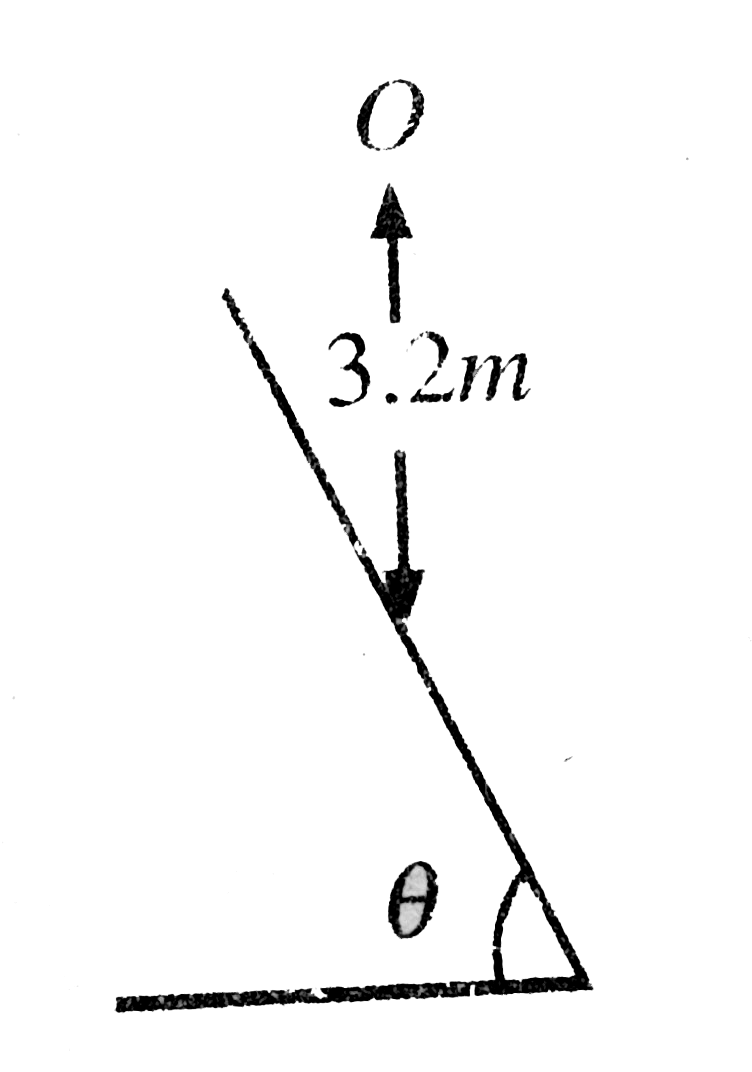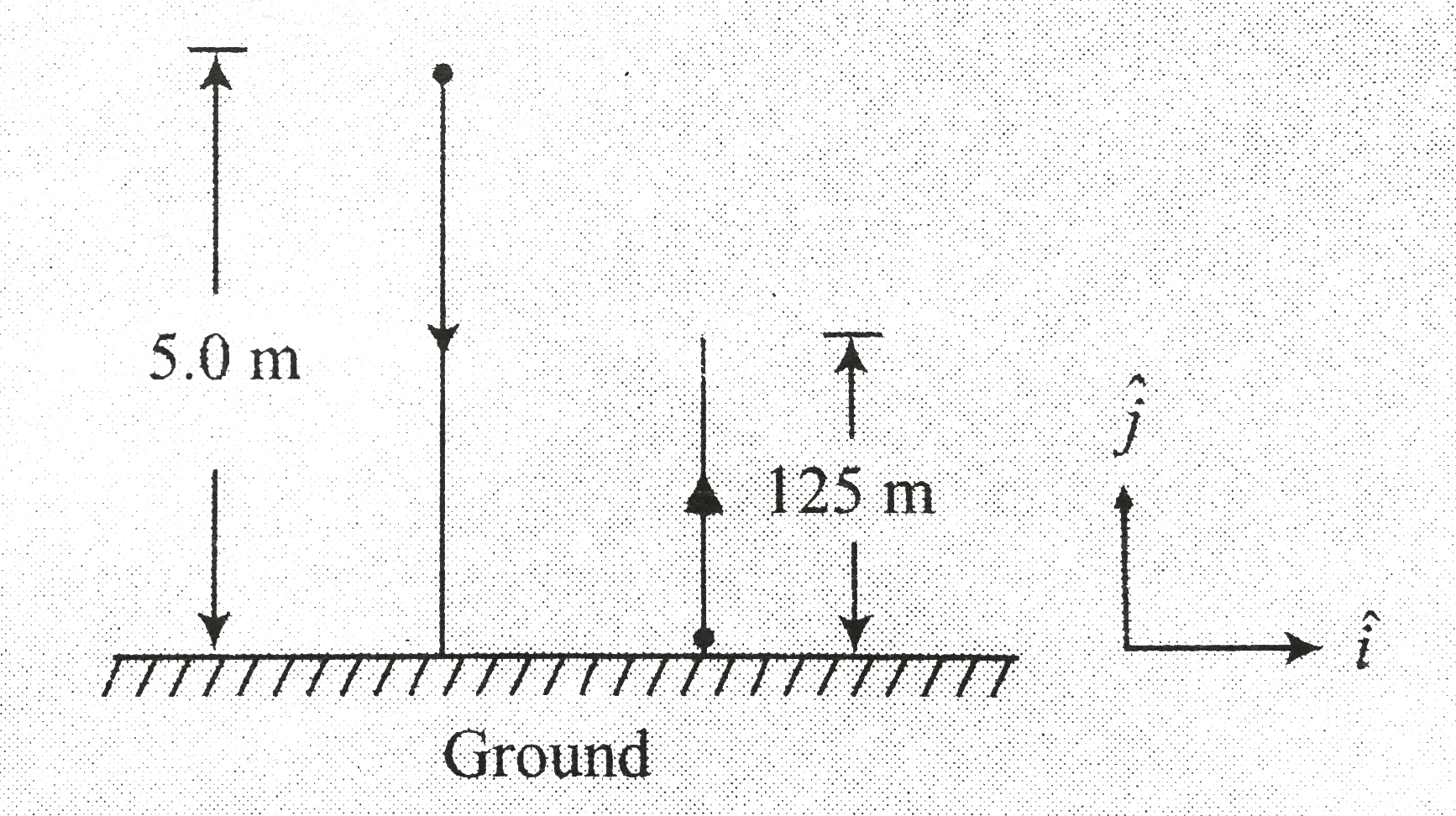A ball of mass 1 kg falls from a height of 5 m above the free surface of water. The relative density of the solid ball is s=23. The ball travels a distance of 2 m under water and becomes stationary. The work done by the resistive forces of water is (−10n)J. Find value of n.
The correct Answer is:4
To solve the problem, we will follow these steps:
Step 1: Determine the work done by gravity
The work done by gravity (Wg) when the ball falls from a height of 5 m to a depth of 2 m underwater can be calculated using the formula:
Wg=m⋅g⋅h
where:
- m=1kg (mass of the ball)
- g=10m/s2 (acceleration due to gravity)
- h=7m (total distance fallen, which is 5 m above water plus 2 m underwater)
Calculating:
Wg=1⋅10⋅7=70J
Step 2: Determine the buoyant force
The buoyant force (Fb) acting on the ball can be calculated using Archimedes' principle:
Fb=ρw⋅V⋅g
where:
- ρw is the density of water (approximately 1000kg/m3)
- V is the volume of the ball, which can be expressed as mρs where ρs is the density of the ball.
Given the relative density s=23, we can express the density of the ball as:
ρs=23⋅ρw=23⋅1000=20003kg/m3
Now, the volume V of the ball is:
V=mρs=120003=32000m3
Now, substituting into the buoyant force equation:
Fb=1000⋅32000⋅10=15N
Step 3: Calculate the work done by the buoyant force
The work done by the buoyant force (Wb) over the distance of 2 m is:
Wb=Fb⋅d
where d=2m:
Wb=15⋅2=30J
Since the buoyant force acts upwards while the ball moves downwards, the work done by buoyant force is negative:
Wb=−30J
Step 4: Apply the work-energy principle
According to the work-energy theorem:
Wg+Wb+Wr=ΔKE
where Wr is the work done by the resistive forces and ΔKE is the change in kinetic energy. Since the ball starts from rest and comes to rest, the change in kinetic energy is zero:
70−30+Wr=0
Step 5: Solve for the work done by resistive forces
Rearranging the equation:
Wr=−70+30=−40J
Step 6: Relate work done by resistive forces to the given expression
We are given that the work done by the resistive forces is −10n:
−10n=−40
Solving for n:
n=4010=4
Final Answer
The value of n is 4.
---
The work done by gravity (Wg) when the ball falls from a height of 5 m to a depth of 2 m underwater can be calculated using the formula:
Wg=m⋅g⋅h
where:
- m=1kg (mass of the ball)
- g=10m/s2 (acceleration due to gravity)
- h=7m (total distance fallen, which is 5 m above water plus 2 m underwater)
Wg=1⋅10⋅7=70J
The buoyant force (Fb) acting on the ball can be calculated using Archimedes' principle:
Fb=ρw⋅V⋅g
where:
- ρw is the density of water (approximately 1000kg/m3)
- V is the volume of the ball, which can be expressed as mρs where ρs is the density of the ball.
ρs=23⋅ρw=23⋅1000=20003kg/m3
V=mρs=120003=32000m3
Fb=1000⋅32000⋅10=15N
The work done by the buoyant force (Wb) over the distance of 2 m is:
Wb=Fb⋅d
where d=2m:
Wb=15⋅2=30J
Since the buoyant force acts upwards while the ball moves downwards, the work done by buoyant force is negative:
Wb=−30J
According to the work-energy theorem:
Wg+Wb+Wr=ΔKE
where Wr is the work done by the resistive forces and ΔKE is the change in kinetic energy. Since the ball starts from rest and comes to rest, the change in kinetic energy is zero:
70−30+Wr=0
Rearranging the equation:
Wr=−70+30=−40J
We are given that the work done by the resistive forces is −10n:
−10n=−40
Solving for n:
n=4010=4
The value of n is 4.
Topper's Solved these Questions
- BOOK - DC PANDEY ENGLISHCHAPTER - PROPERTIES OF MATTEREXERCISE - Matrix Matching12videos
PROPERTIES OF MATTER
- BOOK - DC PANDEY ENGLISHCHAPTER - PROJECTILE MOTIONEXERCISE - Level - 2 Subjective10videos
PROJECTILE MOTION
- BOOK - DC PANDEY ENGLISHCHAPTER - RAY OPTICSEXERCISE - Integer type q.14videos
RAY OPTICS
Similar Questions
A ball of mass 1 kg falls from a height of 5m above the free surface of water. The relative density of the solid ball is s=2/3. The ball travels a distance of 2m under water and becomes stationary. The work done by the resistive forces of water is
View SolutionA ball of mass 1kg is dropped from a height of 3.2m on smooth inclined plane. The coefficient of restitution for the collision is e=1/2. The ball's velocity become horizontal after the collision.
 View Solution
View SolutionA ball of mass 05 kg slows down from a speed of 5 m s−1 to that of 3 m s−1 . Calculate the change in the kinetic energy of the ball.
View SolutionA ball of mass 5.0 gm and relative density 0.5 strikes the surface of the water with a velocity of 20 m/sec. It comes to rest at a depth of 2m. Find the work done by the resisting force in water: (take g=10m/s2)
View SolutionA ball whose density is 0.4×103kg/m3 falls into water from a height of 9 cm. To what depth does the ball sink ?
View SolutionA ball is dropped from a height of 20m above the surface of water in a lake. The refractive index of water is 4/3. A fish inside the lake , in the line fall of the ball, is looking at the ball. At an instant when the balll is 12.8m above the water surface, the fish sees the speed of ball as .
View SolutionA ball of mass 2 kg is gently pushed off the edge of a tabletop that is 1.8 m above the floor. Find the speed of the ball as it strikes the floor.
View SolutionA body of mass 2 kg is dropped from rest from a height 20 m from the surface of Earth. The body hits the ground with velocity 10 m/s, then work done: (g=10m/s2)
View SolutionA rubber ball of mass 50 g falls from a height of 5m and rebounds to a height of 1.25 m. Find the impulse and the average force between the ball and the ground if the time for which they are in contact was 0.1s
 View Solution
View SolutionConsider a drop of rain water having mass 1 g falling from a height of 1km. It hits the ground with a speed of 50m/s Take g constant with a volume 10m/s2. The work done by the
(i) gravitational force and the
(ii) resistive force of air is :View Solution

